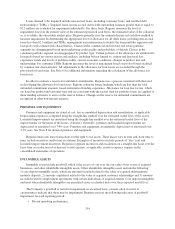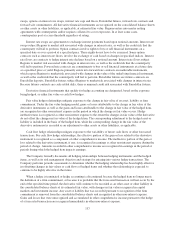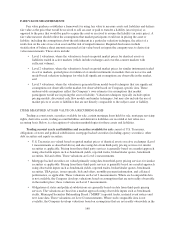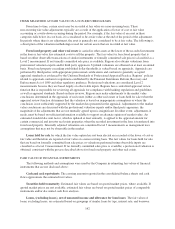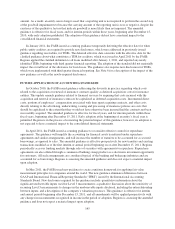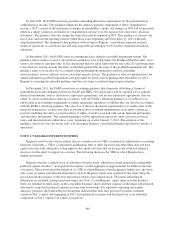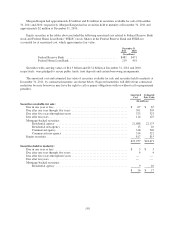Regions Bank 2011 Annual Report Download - page 167
Download and view the complete annual report
Please find page 167 of the 2011 Regions Bank annual report below. You can navigate through the pages in the report by either clicking on the pages listed below, or by using the keyword search tool below to find specific information within the annual report.creditworthiness. Discounted future cash flow analyses are performed for the groupings incorporating
assumptions of current and projected prepayment speeds. Discount rates are determined using the Company’s
current origination rates on similar loans, adjusted for changes in current liquidity and credit spreads (if
necessary) observed in market pricing.
Other interest-earning assets: The carrying amounts reported in the consolidated balance sheets
approximate the estimated fair values.
Deposits: The fair value of non-interest-bearing demand accounts, interest-bearing transaction accounts,
savings accounts, money market accounts and certain other time deposit accounts is the amount payable on
demand at the reporting date (i.e., the carrying amount). Fair values for certificates of deposit are estimated by
using discounted cash flow analyses, based on market spreads to benchmark rates.
Short-term and long-term borrowings: The carrying amounts of short-term borrowings reported in the
consolidated balance sheets approximate the estimated fair values. The fair values of long-term borrowings are
estimated using quoted market prices. If quoted market prices are not available, fair values are estimated using
discounted future cash flow analyses based on current interest rates, liquidity and credit spreads.
Loan commitments and letters of credit: The estimated fair values for these off-balance sheet instruments
are based on probabilities of funding to project expected future cash flows, which are discounted using the loan
methodology described above. The premium/discounts are adjusted for the time value of money over the average
remaining life of the commitments and the opportunity cost associated with regulatory requirements.
See Note 21 for additional information related to fair value measurements.
RECENT ACCOUNTING PRONOUNCEMENTS AND ACCOUNTING CHANGES
In April 2009, the FASB issued additional guidance for estimating fair value when the volume and level of
activity for the asset or liability have significantly decreased. Additionally, the guidance addresses circumstances
that indicate a transaction is not orderly. The guidance emphasizes that even if there has been a significant
decrease in the volume and level of activity for the asset or liability and regardless of the valuation technique(s)
used, the objective of a fair value measurement remains the same. This guidance is effective for interim and
annual reporting periods ending after June 15, 2009, and is applied prospectively. Regions adopted these
provisions during the second quarter of 2009, and the effect of the adoption on the consolidated financial
statements was not material.
In April 2009, the FASB issued additional guidance modifying and expanding other-than-temporary
impairment existing guidance for debt securities. This guidance addresses the unique features of debt securities
and clarifies the interaction of the factors that should be considered when determining whether a debt security is
other-than-temporarily impaired. Additionally, it requires an entity to recognize the credit component of an other-
than-temporary impairment of a debt security in earnings and the noncredit component in other comprehensive
income when the entity does not intend to sell the security and it is more likely than not that the entity will not be
required to sell the security prior to recovery. The guidance also expands and increases the frequency of existing
disclosures about other-than-temporary impairments for debt and equity securities. This guidance is effective for
interim and annual reporting periods ending after June 15, 2009, and is applied prospectively. Regions adopted
these provisions during the second quarter of 2009. Refer to Note 4 for additional information.
In June 2009, the FASB issued accounting guidance related to the accounting for transfers of financial assets.
This guidance eliminates the concept of a qualifying special-purpose entity from consolidation guidance and the
exception for guaranteed mortgage securitizations when a transferor had not surrendered control over the transferred
financial assets. The guidance changes the requirements for derecognizing financial assets and also calls for
additional disclosures about transfers of financial assets. This guidance is effective for fiscal years beginning after
November 15, 2009 and its adoption did not have a material impact to the consolidated financial statements.
143



